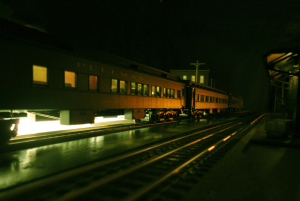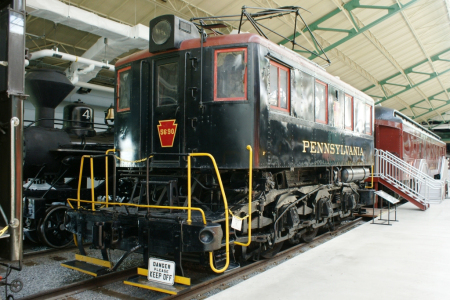
When we think rail yard, we think freight. But passenger trains get yarded too! If you like passenger trains and operations, the coach yard may be just the thing for your railroad.

Passenger operations continued around the clock. While passengers slept, trains rolled through the night and workers in the coach yards prepared consists for morning departures.
The same operations that occur in most freight yards can also be found in passenger yards. Consists are made up; trains are cleaned, serviced and stored. Coach yards are usually located near larger station complexes. Trains are prepared in the yard, then moved to the station for passengers to board. Some additional changes to the trains’ consists may happen at the station platforms as well, including adding or removing passenger cars from connecting trains as well as changes to the mail and express cars at the head end.

In between the commuter rush hours, dozens of trains could be found in the coach yard.
In busy urban areas, the coach yard is often the primary storage facility for commuter trains during the mid-day and overnight hours. While here, the trains are cleaned and inspected. Cars with mechanical defects, anything from a worn brake shoe to a broken toilet, will be taken out of the consist and sent to the car repair shops which are normally located nearby.

Dining cars and Pullmans needed to be cleaned and restocked before their next run.
In addition to coaches, these yards may serve other passenger cars as well. Dining cars and sleepers will need to be stocked with food and receive clean linens. A commissary and storehouse are located adjacent to the yard tracks. Other buildings located nearby would include the car repair shops, business offices and crew quarters.

Sleeping cars would also require service at the coach yard. Cars or entire trains may also need to be turned or change consists.
Most coach yards usually also come equipped with some means of turning trains. A wye may be used, but the most common and efficient means is a reverse loop that can turn the entire train at once without reversing. The yard itself may be built on one half of this loop as a one-way traffic circle. A wash track, like an automatic car wash on a grand scale, would also normally be present. The local commuter trains might not get washed every trip, but the flagship intercity trains certainly would.
Locomotive servicing facilities are usually located nearby as well. These facilities would include fuel and sand stations, wash racks, a roundhouse or similar facility for light maintenance and storage tracks to hold locomotives at the ready until train time. Heavy overhaul back shops were not normally found around the passenger yards due to the more expensive urban real estate they tend to hold. Locomotives in need of heavy repair or inspections would be sent to other yards.
Modeling a Coach Yard
You can add passenger service operations to your layout in a variety of ways. If you are modeling a smaller city where trains don’t terminate, then a few small sidings near the station to hold connecting cars may suffice. Cities near junctions tended to have very busy connections as trains from multiple destinations exchanged cars. Keep a small switcher on hand to do the work. While other passengers, mail and express are being handled at the platform, your switcher can take off the connecting coach or sleeper and attach new cars which had arrived earlier.

Head end traffic was frequently switched at large and smaller terminals alike.
Train schedules were normally coordinated so that these connecting cars did not have to wait in the station for very long. Head end traffic, express boxcars, reefers and Railway Post Office cars can also be exchanged.

The PRR used its B1 switchers (often called “rats”) almost exclusively in coach yards. Small diesel switchers and 0-6-0 or 0-8-0 steam switchers were also common choices for yard power.
A larger terminal could be a model railroad unto itself. A large balloon track could surround the stub-ended storage tracks and other facilities in the middle. Incoming trains will pass around the loop and back in to a holding track. The locomotives would cut off and travel to the engine house nearby for fuel and inspection. Meanwhile, switch engines would take care of any business needed on the train itself, moving the diner to the commissary, setting out a bad order car at the car shops, etc. If the entire train is getting washed, this could be done by the switch crew or by the train crew when the road engines are put back on.
At departure time, express traffic is brought over from the post office and freight house, the road power returns to the train and pulls out to the station. All of this action could be part of a larger railroad, or it could be the railroad. Trains leaving the yard could simply travel out of sight to a hidden staging yard until it is their time to return. Modeling a typical “day” at a coach yard would keep a crew of operators busy and be perfect for the modeler who can’t get enough passenger trains!
Published 5/30/2012